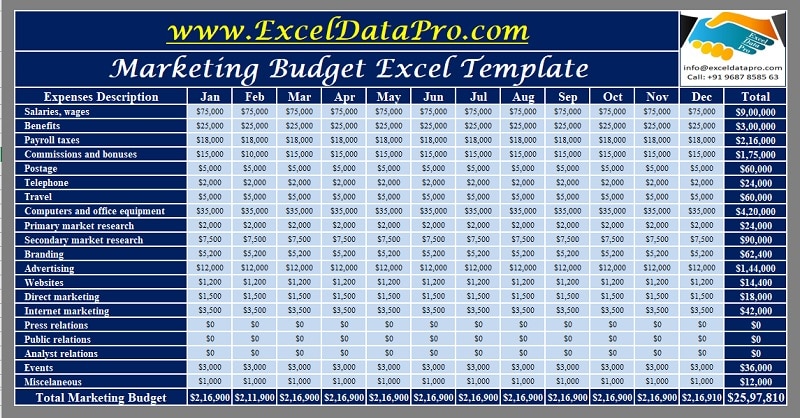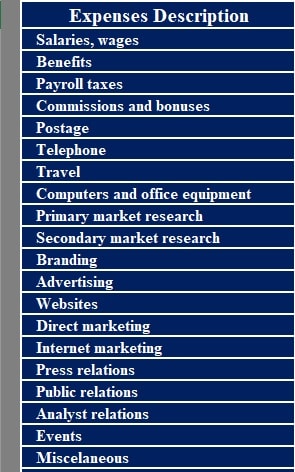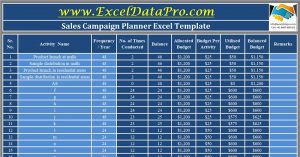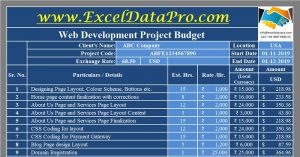
The Marketing Budget Template is a ready-to-use instrument available in Excel, Google Sheets, and OpenOffice formats, designed to facilitate the organization and planning of marketing expenditures.
This resource is invaluable for marketing executives, general managers, and team leaders, as it enables effective management of allocated finances within the marketing department and assists in establishing revenue objectives
Table of Contents
What is a Budget?
A budget is defined as a quantitative expression of an organization’s financial plan for a specified period. It articulates the strategic plans of business units, organizations, activities, or events in measurable terms.
What is a Marketing Budget?
A marketing budget is a document that delineates specific allocations for various marketing activities over a defined timeframe, which may be quarterly, semi-annual, or annual.
These activities encompass a wide range of expenses, including but not limited to branding, promotions, events, commissions, and salaries.
Importance of Marketing Budget
The marketing department is often considered a cornerstone of any organization, with its performance directly impacting revenue figures.
Moreover, Many small and medium-sized enterprises, as well as startups, struggle due to inadequate marketing planning, despite having quality products.
This underscores the critical importance of allocating sufficient resources to promotion and marketing efforts
Proper budgeting allows for prioritization and focus on key marketing activities, facilitating the tracking of return on investment. As a general guideline, companies typically allocate between 5% and 10% of their revenue to marketing initiatives.
Often, companies underspend on marketing activities. There is no doubt that they might be saving some money by not spending. But by not spending on marketing, they tend to missout on a lot of business. Hence, you need to spend money to make money.
Types of Marketing Expenses
Previously, there were a few regular expenses under marketing. But with the digitalisation of marketing activities, a variety of expenses are added to the list.
List of Marketing Expenses
- Online Branding (Website setup and maintenance costs)
- Online Paid Campaigns
- Crisis Management
- Automation tools
- Self and Staff Travel expenses
- Video conferencing and webinars
- Digital Marketing (paid ads on social media and search engines)
- Content Creation (Video production, Images, Blogs, Articles, Guides, etc.)
- Personalised Gifts and samples for customers
- Business cards Expenses
- Brand Collaborations
- Consultancy fees (General as well as digital)
- External Events Participation
- Organising and Promoting your events
- SEO services
The above list consists of marketing expenses, but not limited to these as there can be other expenses.
How To Allocate Your Budget for Marketing?
Follow the following steps to allocate your budget for marketing properly:
- Define clear marketing objectives (e.g., branding, lead generation, or sales)
- Determine the proportion of budget to be allocated to each activity
- Develop a detailed 12-month plan
- Identify appropriate advertising channels
- Analyze past and current performance metrics for each activity
- Allocate budget based on demonstrated results to maximize efficiency
Marketing Budget Template (Excel, Google Sheets, OpenOffice)
To streamline the budgeting process for marketing departments, we have developed a comprehensive Marketing Budget Template with pre-configured formulas.

Excel Google Sheets Open Office Calc
Click here to Download All Accounting Excel Templates for ₹299.
Additionally, you can also download other Accounting Templates like Purchase Return Book With Tax, General Budget With Charts, Accounts Payable With Aging, and many more templates.
Now let us discuss the contents of this template in detail.
Contents of Marketing Budget Template
This template consists of 4 sections: Header Section, Expenses Description, Monthly Budget Amounts, and Totals.
As usual, the Header Section consists of the company name, the company logo, and the sheet heading.

Expense Description
We have tried to list the most applicable expenses to the marketing department. The marketing expenses listed here are as follows:
- Salaries, wages.
- Benefits
- Payroll taxes
- Commissions and bonuses
- Postage
- Telephone
- Travel
- Computers and office equipment
- Primary market research
- Secondary market research
- Branding
- Advertising
- Websites
- Direct marketing
- Internet marketing
- Press relations
- Public relations
- Analyst relations
- Events
- Miscellaneous
If you cannot find any, you can change/add them to the template.

Monthly Budget Amounts
Moreover, one column from Jan to Dec has been given to enter the respective amounts for each month. Insert the amount you wish to spend on the individual activity.

Final Totals Section
In the end, both vertical and horizontal totals are given. The vertical total will provide you with the total expense of a particular month. In comparison, the horizontal total will provide you with a yearly total of each expense.
Other Useful Marketing Templates




We thank our readers for liking, sharing, and following us on different social media platforms.
If you have any queries or suggestions, please share them in the comment section below. I will be more than happy to assist you.
Frequently Asked Questions
How to make my marketing budget effective?
- Research market trends and competitor strategies.
- Implement innovative, distinctive approaches.
- Invest in current trends aligned with your audience.
- Analyze performance metrics regularly.
- Discontinue ineffective strategies; reinvest in successful ones.
- Use ROI KPIs to evaluate financial efficiency.
How much budget should we allocate to social media marketing?
According to a survey, B2B companies should allocate 2-5% of revenue on marketing. Whereas B2C companies should allocate between 5-10% of their revenue on marketing. For more information on how to plan your social media budget, please click the link below:
What are the types of content marketing?
There are five types of content marketing activities: Infographics, Blog content, Podcasts, Videos, and Social media.